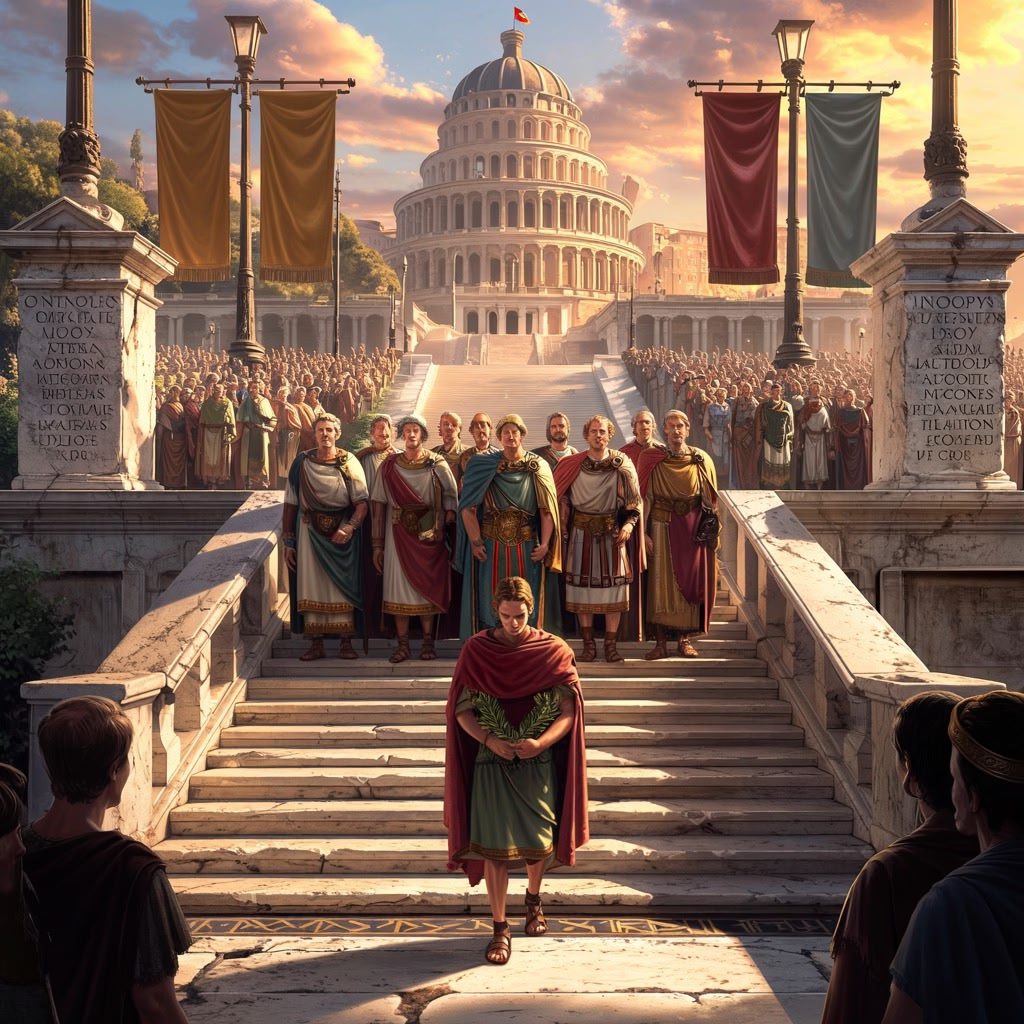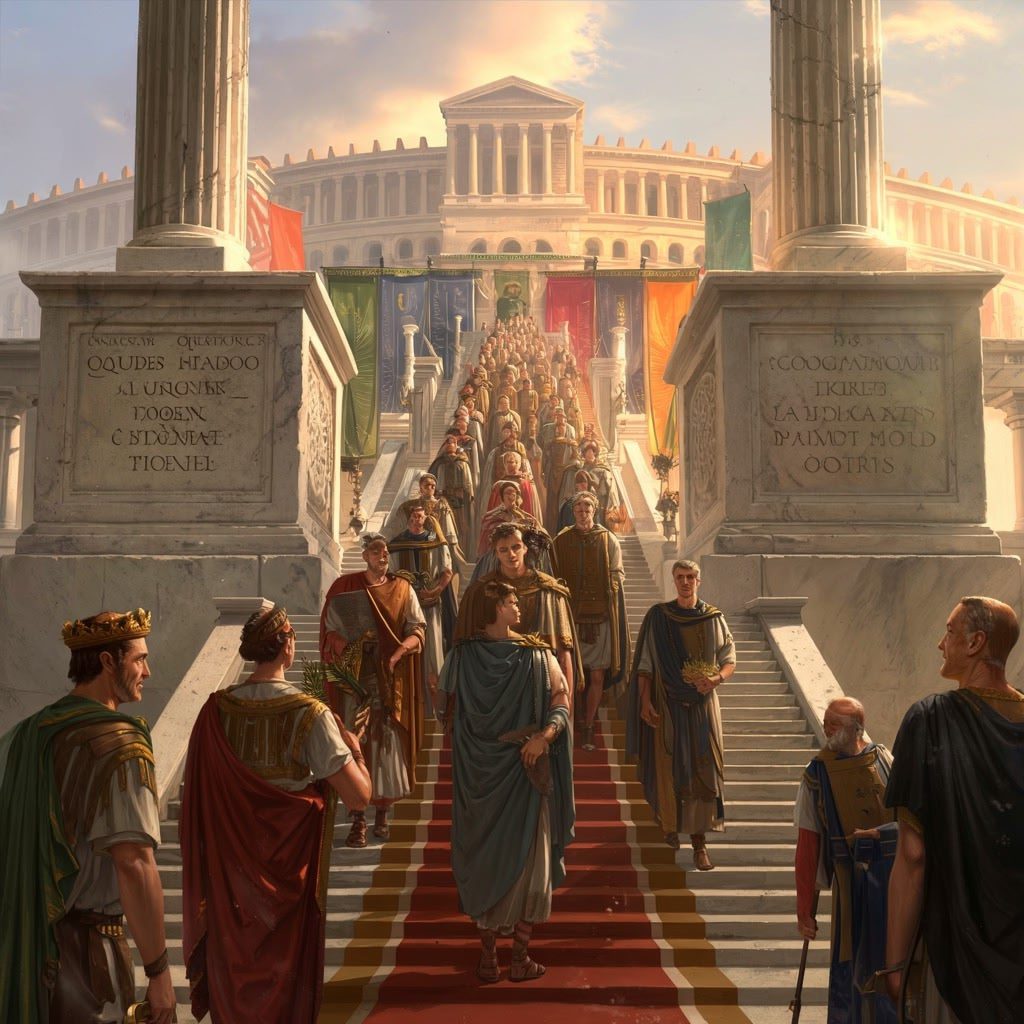Few institutions defined the political and social fabric of ancient Rome as powerfully as the cursus honorum, the structured sequence of public offices that a Roman aristocrat was expected to climb. Translating literally as the “course of honors,” the cursus honorem was more than an administrative career path—it was a civic ladder that molded ambitions, structured competition, and defined what it meant to achieve glory in the Republic.
At its heart, the cursus honorum was a revolutionary experiment in meritocratic and institutionalized career progression. In contrast to monarchies or oligarchies where power was inherited or hoarded within narrow familial lines, Rome formalized a system that required men to prove themselves step by step. Though access was largely restricted to the elite, the system nonetheless gave many “new men” (homines novi) opportunities, and its regulated pathway created stability and accountability in governance, at least in theory.
The cursus honorum became the DNA of Rome’s politics. Its stages—from quaestorship to aedileship, praetorship, and ultimately consulship—mapped onto a life’s work of duty, ambition, and prestige. Along the way, age requirements, collegiality, term limits, and electoral rituals shaped Rome’s extraordinary balancing act between aristocratic privilege and collective governance.
Rome’s Political Framework
The Republic as a Mixed Constitution
Polybius, the Greek historian, admired Rome’s Republic for its “mixed constitution.” Power was not monopolized by one branch but distributed across assemblies, magistrates, and the Senate. The cursus honorum was central to this system: it trained leaders through incremental offices while ensuring constant turnover due to annual elections.
The Concept of Dignitas
Roman culture prized dignitas—personal prestige arising from public service and honorable office. Holding magistracies was not merely a career but a moral imperative for aristocrats. The cursus honorum encoded this lifelong pursuit of glory, channeling competitive instincts into institutionalized stages.

Step One: The Quaestorship
Role and Responsibilities
The quaestorship was the traditional entry point into the cursus honorum. Young men, beginning in their early thirties (minimum age 30, later lowered by Sulla), would stand for election before the popular assemblies. Once elected, quaestors gained entry to the Senate—a critical gateway into Roman political life.
Quaestors managed finances, treasury accounts, and state expenditures. Provincial quaestors served under generals or governors, learning about military administration, taxation, and logistics. This early role forced young aristocrats into both fiscal accountability and networking with more senior statesmen.
Why It Mattered
The quaestorship functioned as trial by fire. It tested young men for reliability, financial probity, and administrative competence. Yet it was also highly prestigious: entry into the Senate guaranteed a lifetime role in deliberative politics.
Step Two: The Aedileship
From Management to Spectacle
After the quaestorship, ambitious Romans could seek election as an aedile (minimum age roughly 36). Aediles oversaw the infrastructure of Rome: streets, markets, temples, and, most famously, public games. This magistracy was optional, unlike others, but carried enormous opportunities for visibility.
Games as Political Theater
Aediles often staged grand gladiatorial spectacles and theatrical shows, funded at their own expense. It was a strategic investment: by dazzling crowds with largesse, an aedile could gather popular support for higher offices later. Caesar, during his aedileship, bankrupt himself with lavish spectacles—but the people adored him.
The Costs of Glory
The role illustrated Rome’s unique fusion of politics, spectacle, and economy. Elections hinged not only on competence but also on one’s willingness to distribute personal wealth for communal delight. Ambition was quite literally purchased with games.

Step Three: The Praetorship
Judicial and Administrative Power
Once a Roman turned forty (minimum age 39), he could stand for praetorship. Praetors wielded judicial authority, overseeing courts of law in Rome. They issued legal edicts and developed precedents that shaped Roman jurisprudence.
Praetors also had imperium, meaning they could command armies and govern provinces. Thus, the praetorship was a crucial transition from mid-level administrator to a serious power broker.
A Springboard to Governorships
Praetorship opened doors to assignments abroad. A praetor might govern Sicily or Hispania, exercising broad autonomy. This exposed him to both opportunities and temptations: wealth through taxation, alliances with locals, and the experience to manage armies.
Praetorship as Consular Training
Holding judicial and provincial responsibilities prepared praetors for the ultimate leap: the consulship. It tested legal acuity, logistical skill, and military capacity in ways designed to polish an aspiring consul into a competent leader.
Step Four: The Consulship
The Pinnacle of the Cursus
The consulship was the crown jewel of the cursus honorum. Reserved for men at least 42 years old, it represented the peak of an aristocrat’s career and carried immense prestige. Two consuls were elected annually, embodying Rome’s principles of collegiality and accountability.
Consuls presided over both Senate and assemblies, introduced legislation, directed state policy, and—most crucially—commanded armies. Victory as consul could immortalize one’s name in stone, triumphal processions, and popular memory.
Fasces: The Symbol of Office
Consuls were accompanied by lictors carrying fasces, bundles of rods and axes symbolizing their authority to punish and command. This image projected Rome’s magistracy as imbued with severity and power. Consuls who celebrated military triumphs were remembered for centuries; their names marked the years of the Roman calendar itself.
Career Apex and Aftermath
After serving as consul, many men entered elder statesmanship, serving as censors or proconsuls with extended commands. Others, like Marius or Caesar, leveraged the consulship as stepping-stones to extraordinary power.

Age Minimums and Sequential Order
Regulated Advancement
The cursus honorum had clear rules about sequence and age:
- Quaestor: minimum around 30 years
- Aedile: 36 years (optional magistracy)
- Praetor: 39 years
- Consul: 42 years
These requirements prevented overly young men from monopolizing power and ensured a measured cycle of progression.
Legal Framework by Sulla
In the 80s BCE, Sulla codified age minimums and mandatory intervals, curbing the erratic careers of earlier generations. His reforms sought to preserve senatorial order and check the rise of ambitious populists.

Exceptions and Shortcuts
Caesar’s Meteoric Rise
Though the cursus honorum was highly regulated, exceptions abounded. Julius Caesar, for example, often bypassed or compressed stages. His immense popularity, combined with political alliances, secured him magistracies earlier than the standard minimum age. His aedileship was spectacular, his praetorship strategically leveraged, and his consulship in 59 BCE marked the culmination of his calculated shortcuts.
Scipio Africanus and Extraordinary Commands
Before Sulla’s reforms, earlier figures like Scipio Africanus gained special commands even before meeting requirements. Scipio received imperium to fight Carthage at a young age, bypassing standard roles due to necessity and exceptional talent.
“Homo Novus” Breakthroughs
Men like Cicero—without aristocratic lineage—demonstrated the cursus honorum’s potential inclusivity. His oratorical brilliance propelled him through each stage, culminating in his consulship in 63 BCE. Cicero became living proof that the cursus, though aristocracy-weighted, could reward merit.
Fascination with the System
Meritocracy in an Ancient Context
What makes the cursus honorum fascinating today is its remarkable balance: on the one hand, a closed aristocratic elite; on the other, a genuine, structured meritocracy for those with ability, eloquence, or military genius. It symbolized Rome’s attempt to regulate power access systematically.
Political Drama and Competition
The cursus encouraged fierce rivalry. Each race for office unfolded in the open, with speeches in the Forum, canvassing, and dramatic appeals to the people. Elections could be theatrical, scandalous, and even violent—bringing republican politics alive in ways we can still vividly imagine.
A Legacy That Outlived the Republic
Even under the Empire, when emperors monopolized real power, echoes of the cursus honorum persisted. Senators still sought quaestorships and praetorships, though often as ceremonial roles confirming rank within the imperial court.
Visual Representations
While we cannot insert actual images here, the following descriptions suggest visuals for a completed article:
- Infographic of the Cursus Honorum: A vertical “ladder” showing stages: Quaestor → Aedile → Praetor → Consul, with age minimums marked.
- Portraits of Roman Magistrates: Busts of Cicero, Caesar, Marius, Scipio to illustrate varied paths.
- Fasces Consulares: Stylized drawing of lictors carrying fasces bundles with axes, symbolizing consular imperium.
Conclusion
The cursus honorum was Rome’s great political invention, a career ladder that balanced aristocratic privilege with systematic merit. Step by step, young men rose from handling finances as quaestors to dazzling with games as aediles, shaping law as praetors, and ultimately commanding Rome itself as consuls.
Though dominated by noble families, the cursus nonetheless rewarded daring outsiders like Cicero and gave ambitious geniuses like Caesar pathways to unprecedented power. It institutionalized ambition, regulated competition, and organized society’s natural drive for honor into structured stages.
For the Romans, climbing this ladder was not just a profession—it was the very essence of civic existence, an honorum pursued for eternal memory. For us today, it remains a fascinating glimpse into one of history’s earliest experiments in structured political meritocracy, complete with its triumphs, flaws, and enduring legacy.

